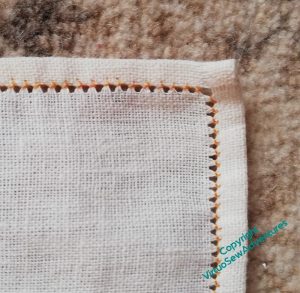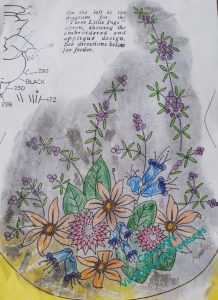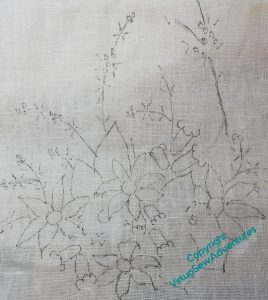Playing With Flox 2
I found a suitable – fairly loosely woven – fabric, and evened up the edges (a lot of unravelling happened!), then hemstitched around the whole thing. In the past, I’ve done the hemstitching last, but as I had a few occasions coming up on which I had time to myself, in public, in which stitching might enable me to be usefully occupied and not loom at people, I thought this was a good use of my time. One reel of cotton, my knitter’s captive blade, and a needle – no other equipment needed, and no risk of losing any of the precious Flox!
Then I did a colour plan for the chosen design. I don’t usually plan pieces like this so much in advance, but since I have limited thread to work with, I picked out a crayon for each colour I had, and had a go. The background is blackened because I first tried to used prick and pounce to transfer the design. It didn’t at all – possibly because the fabric is too loose and all my pounce ended up in gaps rather than on threads. The next attempt was a transfer pencil. That didn’t work either, not at all, no sign of transfer of anything. I wonder whether transfer pencils degrade with time?
So then, which much muttering, I moved on to my cheap and nasty LED lightbox substitute. If I ever find an old-fashioned one I shall leap upon it, LEAP, I tell you.
You can see that I didn’t transfer all lines in all detail. This is a legacy of the Stitch Off, and a result, also, of the efforts I’ve been putting into painting and sketching over the years. This sort of design doesn’t rely on precision, all of the charm of it comes from the sense of life and profusion, and the fabric and thread are both too chunky to allow for much delicacy. So I’m trying to minimise my reliance on guidelines, and indeed, gradually make the guidance still more minimal. A work in progress, again.




These days, I tend to do what you ended up doing: waterproof fineliner and a light box. I have a light grey Derwent one, which is handy for delicate designs. (Or just normal HB pencil if the work will be washed afterwards.) I think most of the fancy transferring methods are likely to degrade over time. And I won’t lose my design by accidentally erasing it or it wearing off during stitching. It’s slow, but still a good bit quicker and easier than tacking through tracing paper. And you can add every detail or just sufficient guidelines and spots to keep yourself on track.
I am looking forward to seeing this one take shape.
Lots of fine problem-solving going on there! Looking forward to seeing more of it.
It will be pretty once you’re underway.
This is going to be an interesting stitch – now you’ve finally got it onto the fabric! The flox thread is intriguing and now I’ve seen the advert you found and read the description, I’m pretty sure I have some pieces stitched with it. I’d always though that the thread was heavily washed and slightly degraded perle, but the description of a softer thread with a lighter twist, now makes sense.
Good to get those edges neatened up first and your design looks lovely and lively. x
My Lightbox is my best friend. I can’t imagine living without it! Most of my designs are transferred using a pencil and a light hand.
Glad you got there in the end.
For the embroidery I’m working on at the moment I used Sticky Fabri- solvy, the type you print your design on on then stick to the fabric. I found it very sticky to start with and had to keep cleaning my needle but it’s ok now probably because it has been quite a while since I did it.
For drawing freehand I like the frixion pens as you can iron off the marks afterwards.
I have switched to hem stitching the sides first as well. It is so much easier to take with you and doesn’t fray. Looking forward to seeing these threads in action.
Your colour plan is a nice sketch too.